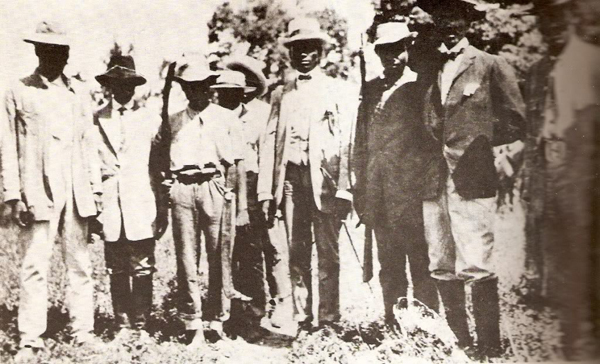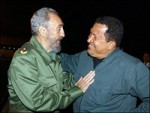Charlemagne Peralte: Haitian Hero, ‘Supreme Bandit’ of First US Occupation – Part II
By Dady Chery
Haiti Chery
Our Charlemagne
On Monday August 30, 1915, Léogane Military Commander Charlemagne Peralte refused to surrender the Haitian flag and his weapons to the U.S. Marines who had been disarming the country. Peralte told the Marines he would only obey an official order from the Haitian President. For his refusal to surrender his flag and weapons without a fight, Peralte was dismissed from Haiti’s Army. He returned to a quiet life of farming in his home town of Hinche, in central Haiti. His resistance to the U.S. occupation might well have ended there if a few months later, the U.S.-controlled Gendarmerie, later called the Forces Armées d’Haiti, FAd’H, had not also come for his person and property.
On the pretext that Charlemagne and Saul Peralte had attacked the Gendarmerie headquarters in Hinche, U.S. officials arrested the brothers and had Charlemagne’s house torched and Saul’s house looted on the night of October 11, 1917.
The brothers were submitted to a court martial that sentenced Saul Peralte to death; he was executed by a Haitian gendarme on the orders of two U.S. officers.
Charlemagne, for his part, was sentenced to 5 years of hard labor in the city of Cap Haitien, where his friends and relatives were made to observe him in prison clothes and with his head shaved in jobs like sweeping the streets. To the minds of the Marines who had come mostly from the U.S. south, this show of force among many would earn them the respect of Haitians, but their overt racism only served to earn them contempt. Additional humiliations from the U.S. included the collection of taxes from Haitians for use to service the foreign debt.
Though respect is not easily gained in Haiti, Charlemagne Peralte and his family had plenty of it. His father, General Remi Massena Peralte, was a land-owning farmer and rancher who had served the country as a member of parliament during the well-regarded administration of President Hyppolite. Charlemagne (born François Borgia Charlemagne Péralte on October 10, 1885) had completed his studies at the well-reputed St. Louis de Gonzague college in Port-au-Prince and then become a career officer in the Haitian army. Before his degradation by the U.S. occupation, he had been a well sought out handsome bachelor and an excellent dancer and hunter.
After nearly a year of forced labor, Charlemagne Peralte escaped with the help of a friend who gave him refuge and disguises. Within a month, Peralte had recruited over 200 rebels, called the Cacos, from the ranks of laboring and escaped convicts, all of whom swore to “drive the Americans back into the sea!”
The Peraltiste Cacos started out armed with only vintage guns and swords from the Haitian Revolution, hunting rifles, machetes, and knives, but they quickly stocked themselves with modern weapons and ammunition by raiding the most remote outposts of the Gendarmerie. They attacked the enemy in surprise commando operations and used guerrilla tactics that favored their mastery of the difficult terrain, particularly along the border of Haiti and the Dominican Republic. Soon Peralte was joined in leading the anti-U.S. war by Mirebalais schoolteacher Benoît Batraville. During the next few months of battle, Peralte would control the North and Battraville the Artibonite region. The Cacos soon grew to include thousands of armed guerrillas, including many Dominicans won over by Peralte to the anti-imperialist cause, and Peralte was able to declare a provisional government in northern Haiti.

Group photo with Charlemagne Peralte. The High Commander of the Haitian Revolution is the tall man in the center with a bow tie.
In 1918, Charlemagne Péralte issued a public call to arms to the people of Haiti, and he wrote a letter to the French Minister in Haiti, signed by himself and 100 others, that was a formal declaration of war against the US. The occupiers continued to refer to the Peraltiste Cacos as a group of bandits and highwaymen, but they realized that a revolution was under way, and the corrupt Gendarmerie could not hold it off. Consequently the US quietly began to upgrade the Marine contingent. The subsequent campaign against the Cacos would involve some of the worst atrocities by the US during its Latin-American imperialist forays. It would also swell the Cacos’ ranks to over 40,000.
Recommended readings:
- Harvest of Hope: Kevin Pina Documentary on Haitian Army, With Review by Dady Chery
- Charlemagne Peralte: “Driving the Americans Back Into the Sea” (German)
Source: Haiti Chery | Thanks to Tortilla con Sal for republication









Comments
Charlemagne Peralte: Haitian Hero, ‘Supreme Bandit’ of First US Occupation – Part II — No Comments